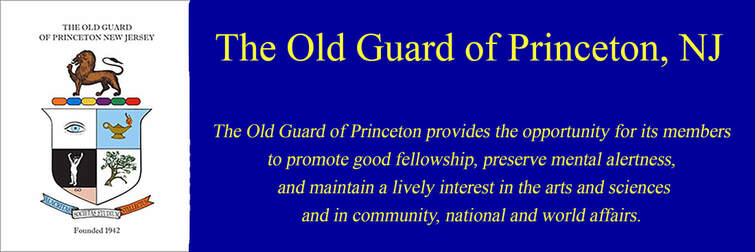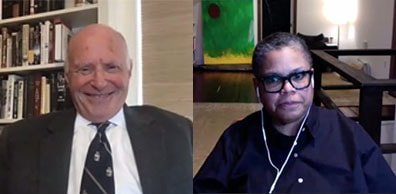January 26, 2022
Race for Profit: How Banks and the Real Estate Industry Undermined Black Homeownership
Keaanga-Yamahtta Taylor
Professor of History and of African American Studies,
Princeton University
Minutes of the 17th Meeting of the 80th Year
Steven Schreiber, Old Guard President, opened and presided over the meeting. Priscilla Roosevelt read the minutes from the January 19 meeting, a presentation by Marna Seltzer about how Richardson Auditorium is managing the current Covid challenge for its programming.
Steven reported 137 unique viewers present via Zoom including five guests: Jim Amon (guest of Mitch Seltzer), Jonathan Weiner (guest of David Rosenfeld), Arati Johnson and Pat Irvin (guest of Henry Von Kohorn) and Marie Burke (guest of Lanny Jones). The first two guests are being introduced as Old Guard applicants.
Henry Von Kohorn introduced our speaker, Keeanga-Yamahtta Taylor, a Princeton University professor in the Department of African American Studies. She is a recent recipient of a MacArthur Foundation “Genius” Fellowship, among other multiple accolades. Her lecture was based on her 2019 book, Race for Profit: How Banks and the Real Estate Industry Undermined Black Home Ownership.
The inner-city riots of the 1960’s (for example, 1965 in Watts in Los Angeles and 1967 in Detroit) were illustrations of the impact of the deteriorating condition of housing in Black communities, often illustrated by referring to the presence of rats. The 1968 Kerner Commission report recommended directly working to address the inner city housing problem.
When Lyndon Johnson managed to get the HUD act of 1968 passed in Congress, it was considered the “Magna Carta for cities,” a bill to support low-income home ownership for African Americans. It was the last of his Great Society bills. Rental public housing for low-income Americans had been the prior model for decades but was deemed a failure.
In theory, this bill provided very generous low-cost mortgage terms and mortgage insurance for the buyers. It also attempted to eliminate redlining, that was preventing
African Americans from an open housing market. However, the bill provided zero oversight or regulation and outsourced the running of the program to the real estate industry. For the real estate industry, their mantra had always been that housing value increased the farther away you were from an African American community.
Due to this reality on the ground, African American buyers were only shown inner city properties that were in poor condition in segregated neighborhoods. Because these inner-city homes were often of substandard quality, when their African American owners failed to keep them up, they were blamed for being lazy or stupid (although they often did cleaning and upkeep on white homes in the suburbs as their day jobs). The real estate and mortgage industry was often acting in a predatory and exploitative fashion.
With the Nixon administration in 1971 and George Romney’s appointment as HUD secretary, any push for desegregation in housing ended. By 1973, ten percent of these inner-city homes were in foreclosure, and many HUD officials were indicted for their lax oversight. However, the real estate and mortgage industry made money no matter what.
By 1974 the concept of home ownership was eliminated and cash vouchers for rentals was introduced as Section 8 vouchers. However, African Americans were only offered used inner-city properties, while low-income whites were offered newer properties in the suburbs.
This has resulted in the continuing racial wealth gap and current economic inequality present in our society, which still tries to rely solely on real estate as the means to build generational wealth.
Respectfully submitted,
Julianne Elward-Berry
Steven reported 137 unique viewers present via Zoom including five guests: Jim Amon (guest of Mitch Seltzer), Jonathan Weiner (guest of David Rosenfeld), Arati Johnson and Pat Irvin (guest of Henry Von Kohorn) and Marie Burke (guest of Lanny Jones). The first two guests are being introduced as Old Guard applicants.
Henry Von Kohorn introduced our speaker, Keeanga-Yamahtta Taylor, a Princeton University professor in the Department of African American Studies. She is a recent recipient of a MacArthur Foundation “Genius” Fellowship, among other multiple accolades. Her lecture was based on her 2019 book, Race for Profit: How Banks and the Real Estate Industry Undermined Black Home Ownership.
The inner-city riots of the 1960’s (for example, 1965 in Watts in Los Angeles and 1967 in Detroit) were illustrations of the impact of the deteriorating condition of housing in Black communities, often illustrated by referring to the presence of rats. The 1968 Kerner Commission report recommended directly working to address the inner city housing problem.
When Lyndon Johnson managed to get the HUD act of 1968 passed in Congress, it was considered the “Magna Carta for cities,” a bill to support low-income home ownership for African Americans. It was the last of his Great Society bills. Rental public housing for low-income Americans had been the prior model for decades but was deemed a failure.
In theory, this bill provided very generous low-cost mortgage terms and mortgage insurance for the buyers. It also attempted to eliminate redlining, that was preventing
African Americans from an open housing market. However, the bill provided zero oversight or regulation and outsourced the running of the program to the real estate industry. For the real estate industry, their mantra had always been that housing value increased the farther away you were from an African American community.
Due to this reality on the ground, African American buyers were only shown inner city properties that were in poor condition in segregated neighborhoods. Because these inner-city homes were often of substandard quality, when their African American owners failed to keep them up, they were blamed for being lazy or stupid (although they often did cleaning and upkeep on white homes in the suburbs as their day jobs). The real estate and mortgage industry was often acting in a predatory and exploitative fashion.
With the Nixon administration in 1971 and George Romney’s appointment as HUD secretary, any push for desegregation in housing ended. By 1973, ten percent of these inner-city homes were in foreclosure, and many HUD officials were indicted for their lax oversight. However, the real estate and mortgage industry made money no matter what.
By 1974 the concept of home ownership was eliminated and cash vouchers for rentals was introduced as Section 8 vouchers. However, African Americans were only offered used inner-city properties, while low-income whites were offered newer properties in the suburbs.
This has resulted in the continuing racial wealth gap and current economic inequality present in our society, which still tries to rely solely on real estate as the means to build generational wealth.
Respectfully submitted,
Julianne Elward-Berry

